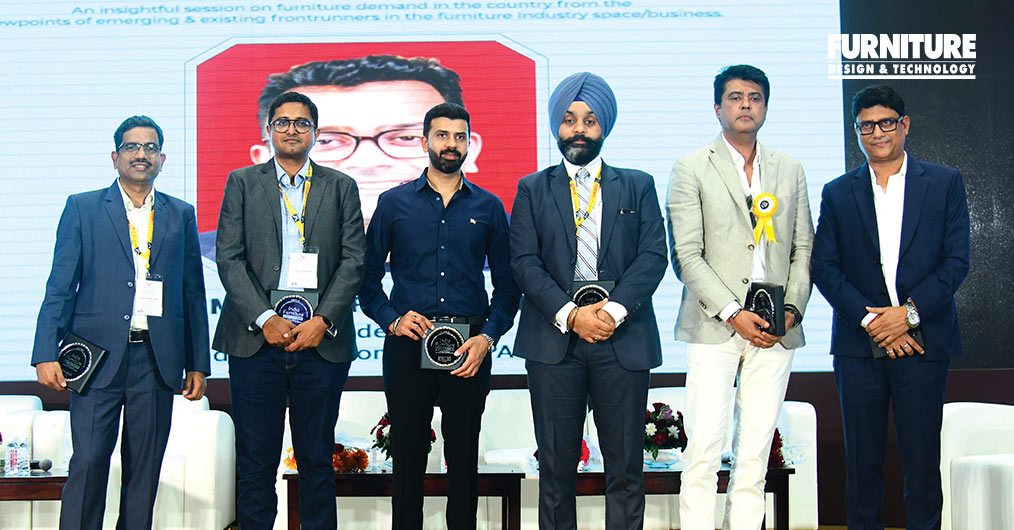
The Consumer Mindset in Big Metros & Tier 2 Cities session, conducted during the India Furniture Conclave 2023 as part of MATECIA, was a resounding success. This session, held on September 22, 2023, drew the attention of prominent industry leaders, architects and designers, establishing itself as a significant highlight of the event. During the engaging Consumer Mindset session, a panel of experts, including Ar Bobby Mukherjee, Founder, BMA; Mr Ajit Bhartia, CEO, Crystal Furnitech; Mr Thomas Markose, Director, Aristo; Mr Tejas Timbadia, Director, The Colosseum; and Mr Muninder Pal Singh, Strategic Consultant, Cushman & Wakefield India explored the evolving consumer landscape in major metropolitan areas and Tier 2 cities. This discussion delved into changing consumer expectations, purchasing capacity and trends, particularly in the furniture, kitchen, wardrobe and hardware sectors, and was adeptly moderated by Mr Pragat Dvivedi, Founder, IIR and FDT.
Mr Dvivedi commenced the session by addressing the topic of Consumer’s Mindset in Metros and Tier 2 Cities. He emphasized the importance of this topic, stating, “We all are salesmen, meaning when I see post-COVID in 2023, everyone is selling something or other. In a way, all of us are Salesmen. He acknowledged that interior designers and architects are essentially salesmen because they aim to showcase their beautifully designed products and designs. He noted that the act of presenting a design (to a client) is a form of selling. He elaborated, “Till we don’t sell, no one will consume, right? I feel that the real salesmanship is the same.”
The Evolution of Indian Design In a candid conversation Ar Mukherjee, offered his insights into the remarkable transformation of the Indian design landscape, drawing a clear line between the pre-2014 era and the present day. He recalled, “I had come back from the West and I realized that, with all my knowledge and skills, I was unable to execute high-quality work in my own country.” Back then, India’s dependence on Western manufacturers was evident. The Euro and the Dollar were favourable for affordable imports, and projects flourished with products from these sources. “After a decade, the Chinese came in because the Euro and Dollar started becoming stronger, and the Chinese products were high in quality and affordable.”

He added, despite the dominance of the Chinese products, a notable shift began about five years ago, amplified by the weakening Indian Rupee, the pandemic, and growing nationalistic sentiments. Indian manufacturers responded by enhancing product quality and investing in state-of-the-art equipment, not just in furniture but also in lighting, building materials, fabrics, upholsteries and metalworks.
Ar Mukherjee observed, “Now, in our projects, which run into thousands of crores in interior works, our primary reliance is on Indian manufacturers.” Indian manufacturers embraced innovation and quality, aligning with international standards. He credited this shift to exposure gained through major European expos. Likewise affordable design-oriented brands like IKEA who entered India played a crucial role in raising the bar. That being said, while Ar Mukherjee is optimistic about India’s design future, he acknowledges that it will take some time. “A time will come in the next 20-30 years, where we will be at par with Italy in terms of quality and everything.”
This article is a part of our exclusive article ‘Consumers Mindset of Metros & Tier 2 Cities’ which is originally published in Furniture Design & Technology (FDT Magazine) November 2023 print issue. If you want to read the full article, please subscribe Furniture Design & Technology Magazine here:
Furniture Design India and the magazine FURNITURE DESIGN & TECHNOLOGY (FDT magazine) are from the trusted 22-year-old media house of SURFACES REPORTER and PLY REPORTER.
FDT is a B2B monthly bilingual magazine from India that shares the pulse of the furniture business in India and connects the manufacturers, OEMS, product designers, architects, showrooms, designers and dealers.
Read More© 2025 Furniture Design and Technologies.. All Rights Reserved. Developed by eyeQ Advertising